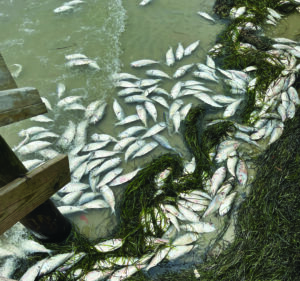
No one in then Virginia political hierarchy seems concerned that the menhaden reduction fleet based in Reedville is taking food from the mouths of stripers, trout, and other Virginia gamefish, but maybe they’ll pay attention as osprey nests begin to disappear. Ospreys feed heavily on menhaden and when vast schools of the oily baitfish instantly disappear, the food in that entire area for these majestic predators is also gone.
Recently, the Richmond Audubon Society filed a formal request for a temporary emergency closure of purse seine fishing in the Chesapeake Bay to protect osprey. Virginia menhaden laws authorize the VMRC to enact emergency temporary regulations any time a natural resource needs immediate protection. If enacted, the regulation would prohibit purse seine fishing in the entire the bay from the Town of Cape Charles north to the Maryland state line for 30 days. The intent is to allow osprey to feed in preparation for their fall migration to South America. Osprey nests failed this summer in Gloucester, York and Mathews Counties at a rate not seen since the DDT crisis. The nest failures were due to starvation caused by lack of available menhaden. Audubon is looking for the regulation to be in effect during the months of August and September.
The Eastern Shore Post reported that a group of commercial and recreational fishermen is suing the Virginia Marine Resources Commission for not protecting the Chesapeake Bay’s population of menhaden – the primary food source for many sport fish, including the threatened striped bass.
The menhaden are not only food for larger fish and birds like ospreys, but they are also filter feeders that help clean the Chesapeake Bay. They eat algae, which can overgrow, forming blooms that block sunlight from marine plants. The death and decay of these algal blooms also deprive marine life of oxygen.
According to the lawsuit, the menhaden population decline caused “damage to Virginia waters” that influenced a decline in organization membership, revenue, and the number of programs the organization can support.
Nearly 1 million recreational fishermen in Virginia contribute $1.3 billion in economic output and support almost 10,000 jobs.
Omega Protein, a Canadian company, operates the East Coast’s last remaining menhaden reduction fishery, which is in the Chesapeake Bay. The reduction fishery is so named because the menhaden are reduced to make fish meal, oil, and other supplements.
VMRC granted Omega Protein, called the “Industrial Harvester” in the lawsuit, 90% of Virginia’s annual allowable catch of menhaden, about 158,000 metric tons, which is 21,000 metric tons more than it was permitted to catch last year.
The lawsuit notes that since only 51,000 metric tons of menhaden can be taken from the bay, the remaining 107,000 metric tons of menhaden must be caught elsewhere in Virginia waters.
However, Omega Protein harvests the rest of the menhaden in and near the mouth of the Chesapeake Bay, further depleting the menhaden in the bay and preventing other menhaden from entering the bay and replenishing the menhaden population, the plaintiff contends.
The lawsuit argues that VMRC acted unlawfully when it “rubber-stamped” the Atlantic Interstate Commission’s new menhaden catch limit without considering available scientific data or applying conservation and management practices as required by Virginia statute.
The plaintiff is asking the court for relief including striking the adopted regulation, requiring VMRC to rewrite the regulation in a manner that protects Virginia waters and the Chesapeake Bay, setting a timeline for VMRC to complete its analysis and enact the new regulation, and awarding the petitioner’s costs and attorneys’ fees.
Maybe our courts can accomplish what our politicians have refused to do – to save the menhaden and to save the Chesapeake Bay, Virginia’s most precious natural resource.

